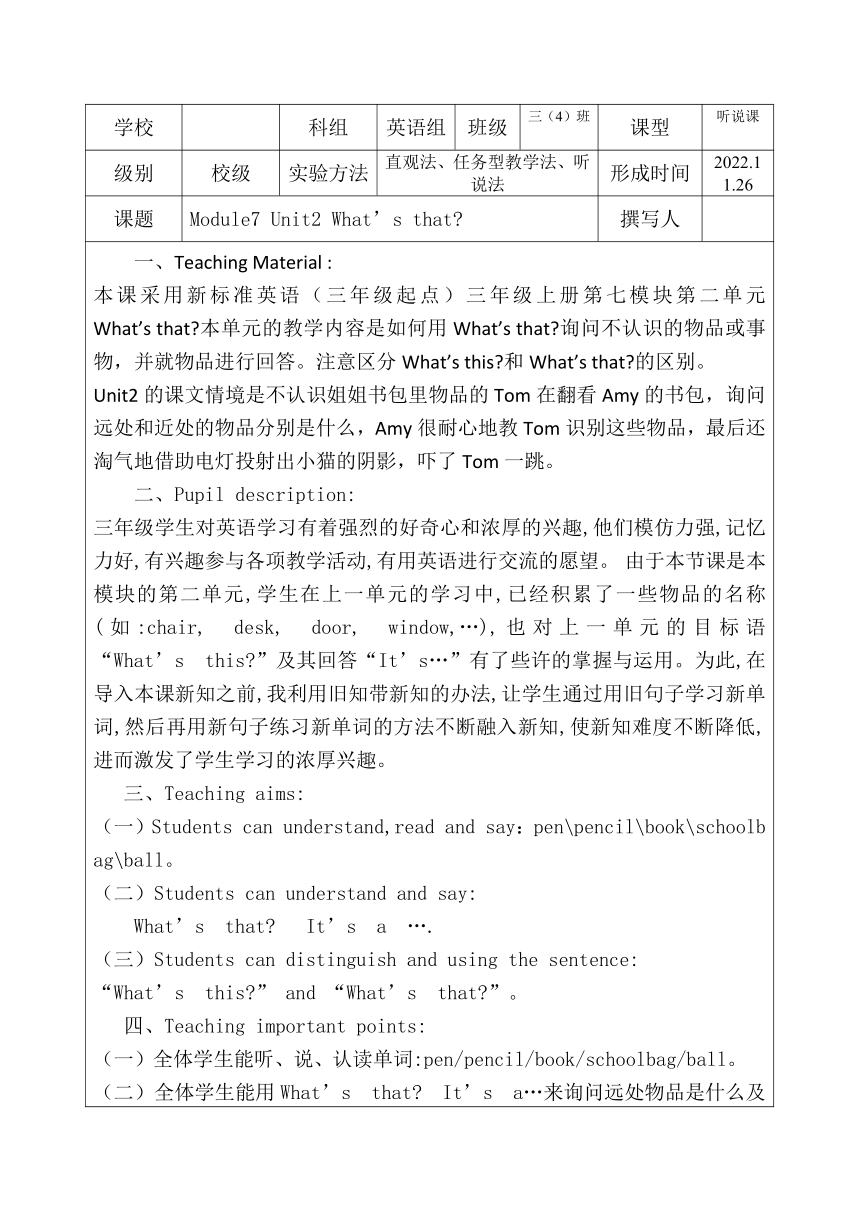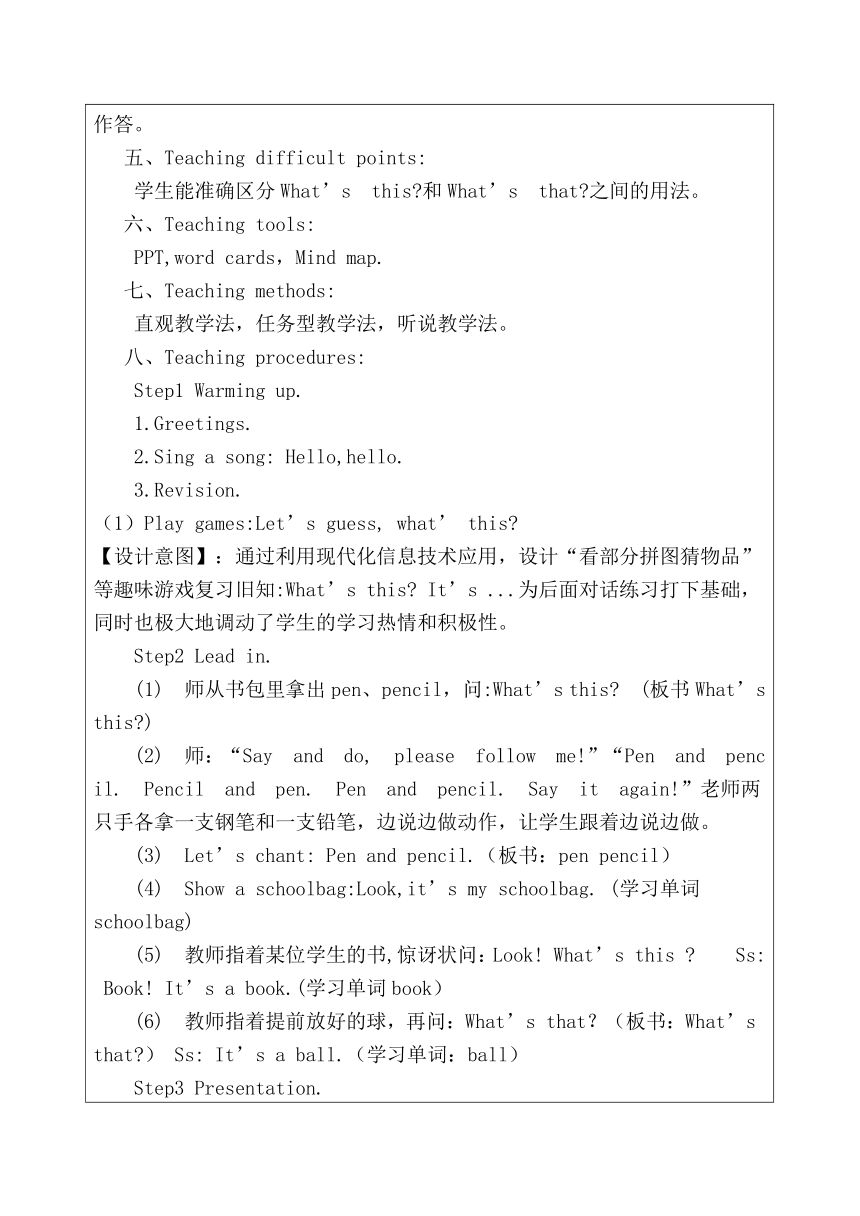Module7 Unit2 What’s that?表格式教案(含反思)
文档属性
| 名称 | Module7 Unit2 What’s that?表格式教案(含反思) |  | |
| 格式 | zip | ||
| 文件大小 | 98.9KB | ||
| 资源类型 | 教案 | ||
| 版本资源 | 外研版(三年级起点) | ||
| 科目 | 英语 | ||
| 更新时间 | 2023-01-30 17:22:47 | ||
图片预览


文档简介
学校 科组 英语组 班级 三(4)班 课型 听说课
级别 校级 实验方法 直观法、任务型教学法、听说法 形成时间 2022.11.26
课题 Module7 Unit2 What’s that 撰写人
Teaching Material : 本课采用新标准英语(三年级起点)三年级上册第七模块第二单元What’s that 本单元的教学内容是如何用What’s that 询问不认识的物品或事物,并就物品进行回答。注意区分What’s this 和What’s that 的区别。 Unit2的课文情境是不认识姐姐书包里物品的Tom在翻看Amy的书包,询问远处和近处的物品分别是什么,Amy很耐心地教Tom识别这些物品,最后还淘气地借助电灯投射出小猫的阴影,吓了Tom一跳。 Pupil description: 三年级学生对英语学习有着强烈的好奇心和浓厚的兴趣,他们模仿力强,记忆力好,有兴趣参与各项教学活动,有用英语进行交流的愿望。 由于本节课是本模块的第二单元,学生在上一单元的学习中,已经积累了一些物品的名称(如:chair, desk, door, window,…),也对上一单元的目标语“What’s this ”及其回答“It’s…”有了些许的掌握与运用。为此,在导入本课新知之前,我利用旧知带新知的办法,让学生通过用旧句子学习新单词,然后再用新句子练习新单词的方法不断融入新知,使新知难度不断降低,进而激发了学生学习的浓厚兴趣。 Teaching aims: (一)Students can understand,read and say:pen\pencil\book\schoolbag\ball。 (二)Students can understand and say: What’s that It’s a …. Students can distinguish and using the sentence: “What’s this ” and “What’s that ”。 Teaching important points: (一)全体学生能听、说、认读单词:pen/pencil/book/schoolbag/ball。 (二)全体学生能用What’s that It’s a…来询问远处物品是什么及作答。 Teaching difficult points: 学生能准确区分What’s this 和What’s that 之间的用法。 Teaching tools: PPT,word cards,Mind map. Teaching methods: 直观教学法,任务型教学法,听说教学法。 Teaching procedures: Step1 Warming up. 1.Greetings. 2.Sing a song: Hello,hello. 3.Revision. (1)Play games:Let’s guess, what’ this 【设计意图】:通过利用现代化信息技术应用,设计“看部分拼图猜物品”等趣味游戏复习旧知:What’s this It’s ...为后面对话练习打下基础,同时也极大地调动了学生的学习热情和积极性。 Step2 Lead in. 师从书包里拿出pen、pencil,问:What’s this (板书What’s this ) 师:“Say and do, please follow me!”“Pen and pencil. Pencil and pen. Pen and pencil. Say it again!”老师两只手各拿一支钢笔和一支铅笔,边说边做动作,让学生跟着边说边做。 Let’s chant: Pen and pencil.(板书:pen pencil) Show a schoolbag:Look,it’s my schoolbag. (学习单词schoolbag) 教师指着某位学生的书,惊讶状问:Look! What’s this Ss: Book! It’s a book.(学习单词book) 教师指着提前放好的球,再问:What’s that?(板书:What’s that ) Ss: It’s a ball.(学习单词:ball) Step3 Presentation. The teacher introduces Tom to students: Look at the two pictures of Tom. At first, Tom is happy, but then he is scared. So what happened Let’s have a look!(通过对比小汤姆的两幅表情图,推断可能发生了什么,调动起孩子们的好奇心。) The teacher talks about pictures with students. What’s Tom doing Why is Tom asking Amy Guess what Tom will say to Amy (What’s this What’s that ) The students listen to the recorder, and answer “What’s that ” This and that? Show a picture of pandas and try to understand the two words. Show a cat and a dog. (借助实物和图片对this 和that进行对比,让学生学会区分两个单词的用法。) The students watch the video and read the dialogue loudly. Read with your partner. Read in roles. Step4 Practise. This and that? Show a picture of Baymax and try to understand the two words. (设计意图:借助实物和图片对this和that进行对比,让学生学会区分两个单词的用法。) Step5 Summary Emotions: Maybe you have a little sister or a brother. When he/she have questions,please tell him/her. Try to help him/her. Because he/ she is your family. (结合本节课内容,挖掘德育点:你或许当了姐姐或哥哥,当你的弟弟或妹妹问你问题或需要你帮助时,请告诉他,帮助她。因为,你们是一家人。) 看着板书总结本节课内容,Let’s chant: That, that, what’s that Book, book, it’s a book. That, that, what’s that Ball, ball, it’s a book. That, that, what’s that Bag, bag, schoolbag. (设计意图:通过这首chant,让学生更好地巩固本节课所学单词和重点句型。) Step6 Homework (一)Listen and try to repeat the text. (二)Draw and guess with your partner. (三)Try to sing the chant for your parents. Step7 Blackboard design. (设计意图:本环节让学生对本节课的重点内容一目了然。) 通过本节课的教学,我觉得有以下几个地方做得比较好: 一、课件设计不错,难度适中,教具准备充足。 二、课前用儿歌《hello! Hello!》热身,带动学生热身,可以很快激发学生学习的兴趣,活跃课堂气氛。 三、复习导入环节能够做好有效衔接,复习到上节课内容,也能为下面课文的学习练习做好铺垫。 四、教学新单词时,我利用实物教具辅助进行教学,有利于学生们进行单词理解。并且能把单词放到情境中教学,做到词不离句,词不离文。 六、在课文教学中,我通过听并回答、听并选择、听并跟读、分角色朗读等方式加强学生的听力和语音训练,培养了学生良好的英语语感和相互合作学习精神。 七、情感目标制定贴近生活实际,教育孩子们要耐心帮助自己的兄弟姐妹。 八、板书采用“创意书包”设计,能根据三年级学生热爱趣味图画的学情,做到围绕本课主题,突出本课教学的重点内容。 不足之处: 一、Role play环节未能运用角色头饰和没有进行师生示范。 二、在进行单词教学时,未能带着学生进行单词书空。
级别 校级 实验方法 直观法、任务型教学法、听说法 形成时间 2022.11.26
课题 Module7 Unit2 What’s that 撰写人
Teaching Material : 本课采用新标准英语(三年级起点)三年级上册第七模块第二单元What’s that 本单元的教学内容是如何用What’s that 询问不认识的物品或事物,并就物品进行回答。注意区分What’s this 和What’s that 的区别。 Unit2的课文情境是不认识姐姐书包里物品的Tom在翻看Amy的书包,询问远处和近处的物品分别是什么,Amy很耐心地教Tom识别这些物品,最后还淘气地借助电灯投射出小猫的阴影,吓了Tom一跳。 Pupil description: 三年级学生对英语学习有着强烈的好奇心和浓厚的兴趣,他们模仿力强,记忆力好,有兴趣参与各项教学活动,有用英语进行交流的愿望。 由于本节课是本模块的第二单元,学生在上一单元的学习中,已经积累了一些物品的名称(如:chair, desk, door, window,…),也对上一单元的目标语“What’s this ”及其回答“It’s…”有了些许的掌握与运用。为此,在导入本课新知之前,我利用旧知带新知的办法,让学生通过用旧句子学习新单词,然后再用新句子练习新单词的方法不断融入新知,使新知难度不断降低,进而激发了学生学习的浓厚兴趣。 Teaching aims: (一)Students can understand,read and say:pen\pencil\book\schoolbag\ball。 (二)Students can understand and say: What’s that It’s a …. Students can distinguish and using the sentence: “What’s this ” and “What’s that ”。 Teaching important points: (一)全体学生能听、说、认读单词:pen/pencil/book/schoolbag/ball。 (二)全体学生能用What’s that It’s a…来询问远处物品是什么及作答。 Teaching difficult points: 学生能准确区分What’s this 和What’s that 之间的用法。 Teaching tools: PPT,word cards,Mind map. Teaching methods: 直观教学法,任务型教学法,听说教学法。 Teaching procedures: Step1 Warming up. 1.Greetings. 2.Sing a song: Hello,hello. 3.Revision. (1)Play games:Let’s guess, what’ this 【设计意图】:通过利用现代化信息技术应用,设计“看部分拼图猜物品”等趣味游戏复习旧知:What’s this It’s ...为后面对话练习打下基础,同时也极大地调动了学生的学习热情和积极性。 Step2 Lead in. 师从书包里拿出pen、pencil,问:What’s this (板书What’s this ) 师:“Say and do, please follow me!”“Pen and pencil. Pencil and pen. Pen and pencil. Say it again!”老师两只手各拿一支钢笔和一支铅笔,边说边做动作,让学生跟着边说边做。 Let’s chant: Pen and pencil.(板书:pen pencil) Show a schoolbag:Look,it’s my schoolbag. (学习单词schoolbag) 教师指着某位学生的书,惊讶状问:Look! What’s this Ss: Book! It’s a book.(学习单词book) 教师指着提前放好的球,再问:What’s that?(板书:What’s that ) Ss: It’s a ball.(学习单词:ball) Step3 Presentation. The teacher introduces Tom to students: Look at the two pictures of Tom. At first, Tom is happy, but then he is scared. So what happened Let’s have a look!(通过对比小汤姆的两幅表情图,推断可能发生了什么,调动起孩子们的好奇心。) The teacher talks about pictures with students. What’s Tom doing Why is Tom asking Amy Guess what Tom will say to Amy (What’s this What’s that ) The students listen to the recorder, and answer “What’s that ” This and that? Show a picture of pandas and try to understand the two words. Show a cat and a dog. (借助实物和图片对this 和that进行对比,让学生学会区分两个单词的用法。) The students watch the video and read the dialogue loudly. Read with your partner. Read in roles. Step4 Practise. This and that? Show a picture of Baymax and try to understand the two words. (设计意图:借助实物和图片对this和that进行对比,让学生学会区分两个单词的用法。) Step5 Summary Emotions: Maybe you have a little sister or a brother. When he/she have questions,please tell him/her. Try to help him/her. Because he/ she is your family. (结合本节课内容,挖掘德育点:你或许当了姐姐或哥哥,当你的弟弟或妹妹问你问题或需要你帮助时,请告诉他,帮助她。因为,你们是一家人。) 看着板书总结本节课内容,Let’s chant: That, that, what’s that Book, book, it’s a book. That, that, what’s that Ball, ball, it’s a book. That, that, what’s that Bag, bag, schoolbag. (设计意图:通过这首chant,让学生更好地巩固本节课所学单词和重点句型。) Step6 Homework (一)Listen and try to repeat the text. (二)Draw and guess with your partner. (三)Try to sing the chant for your parents. Step7 Blackboard design. (设计意图:本环节让学生对本节课的重点内容一目了然。) 通过本节课的教学,我觉得有以下几个地方做得比较好: 一、课件设计不错,难度适中,教具准备充足。 二、课前用儿歌《hello! Hello!》热身,带动学生热身,可以很快激发学生学习的兴趣,活跃课堂气氛。 三、复习导入环节能够做好有效衔接,复习到上节课内容,也能为下面课文的学习练习做好铺垫。 四、教学新单词时,我利用实物教具辅助进行教学,有利于学生们进行单词理解。并且能把单词放到情境中教学,做到词不离句,词不离文。 六、在课文教学中,我通过听并回答、听并选择、听并跟读、分角色朗读等方式加强学生的听力和语音训练,培养了学生良好的英语语感和相互合作学习精神。 七、情感目标制定贴近生活实际,教育孩子们要耐心帮助自己的兄弟姐妹。 八、板书采用“创意书包”设计,能根据三年级学生热爱趣味图画的学情,做到围绕本课主题,突出本课教学的重点内容。 不足之处: 一、Role play环节未能运用角色头饰和没有进行师生示范。 二、在进行单词教学时,未能带着学生进行单词书空。
同课章节目录
- Module 1
- Unit 1 I'm Sam.
- Unit 2 How are you?
- Module 2
- Unit 1 I'm Ms Smart.
- Unit 2 What's your name?
- Module 3
- Unit 1 Point to door.
- Unit 2 Point to desk.
- Module 4
- Unit 1 It's red!
- Unit 2 It's a black dog.
- Module 5
- Unit 1 How many?
- Unit 2 Nine girls?
- Module 6
- Unit 1 Happy birthday!
- Unit 2 How old are you?
- Module 7
- Unit 1 What's this?
- Unit 2 What's that?
- Module 8
- Unit 1 Is it a monster?
- Unit 2 Where's the cat?
- Module 9
- Unit 1 This is my mothe
- Unit 2 He's a doctor.
- Module 10
- Unit 1 This is his head.
- Unit 2 Point to her nose
- Review Module
- Unit 1
- Unit 2
